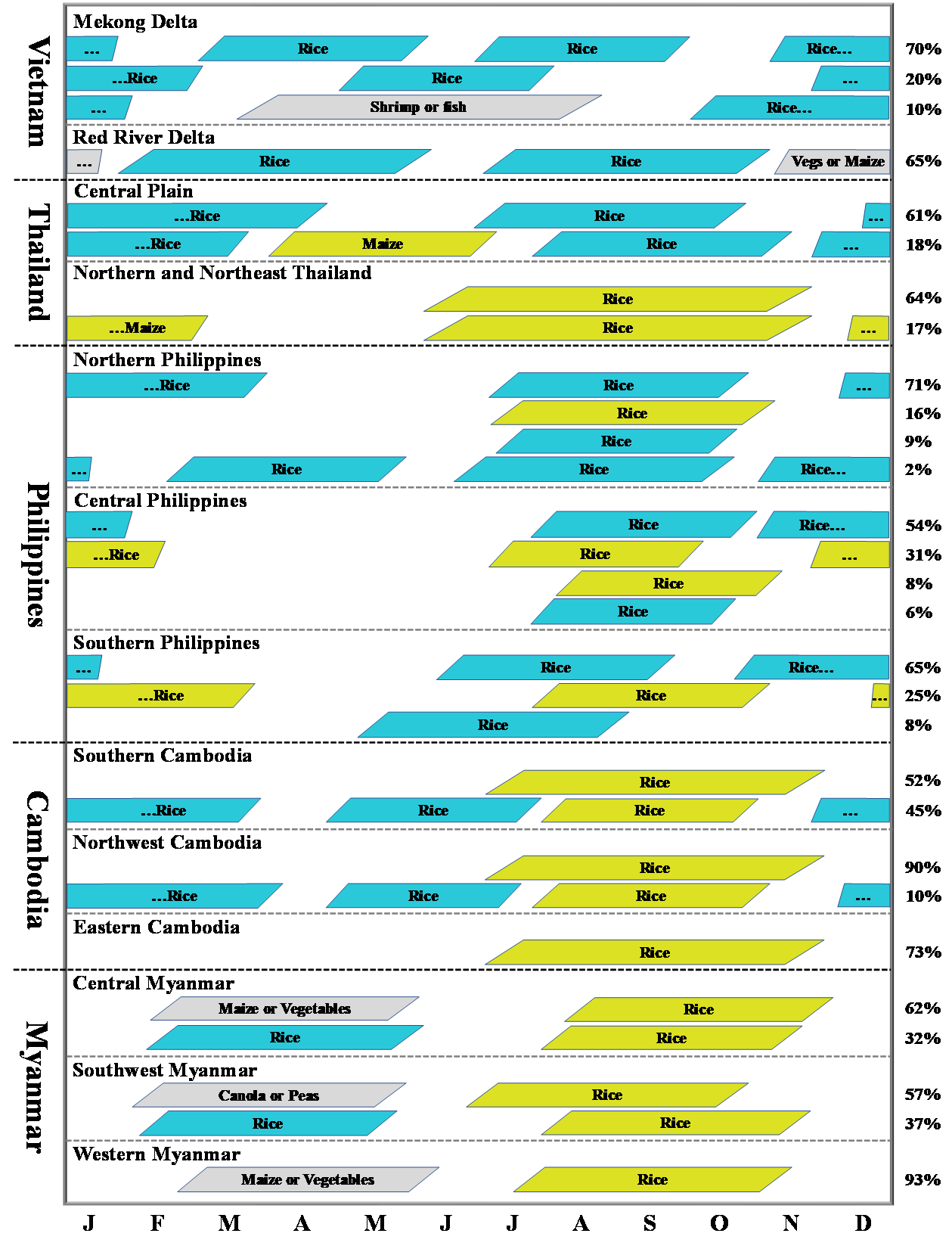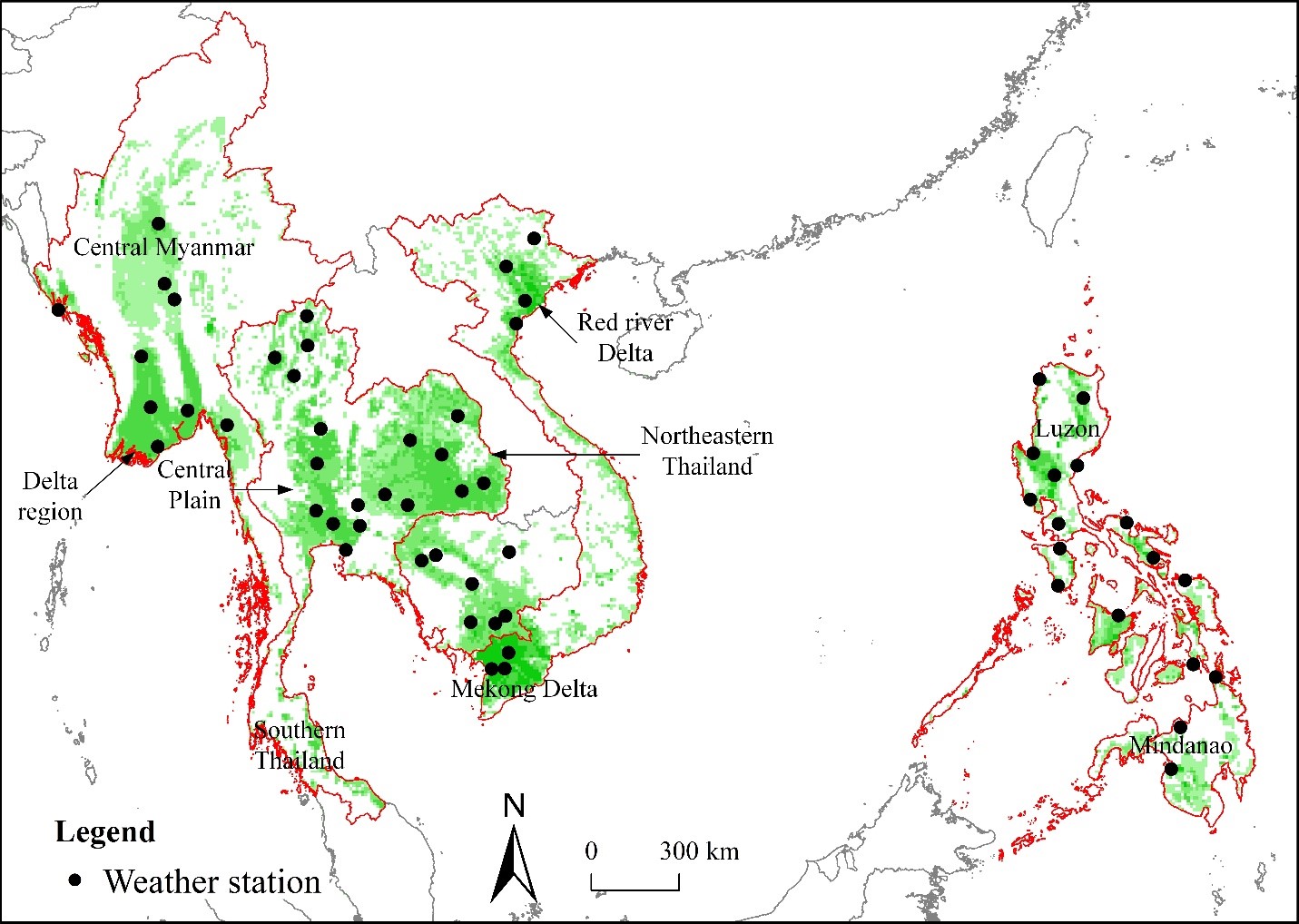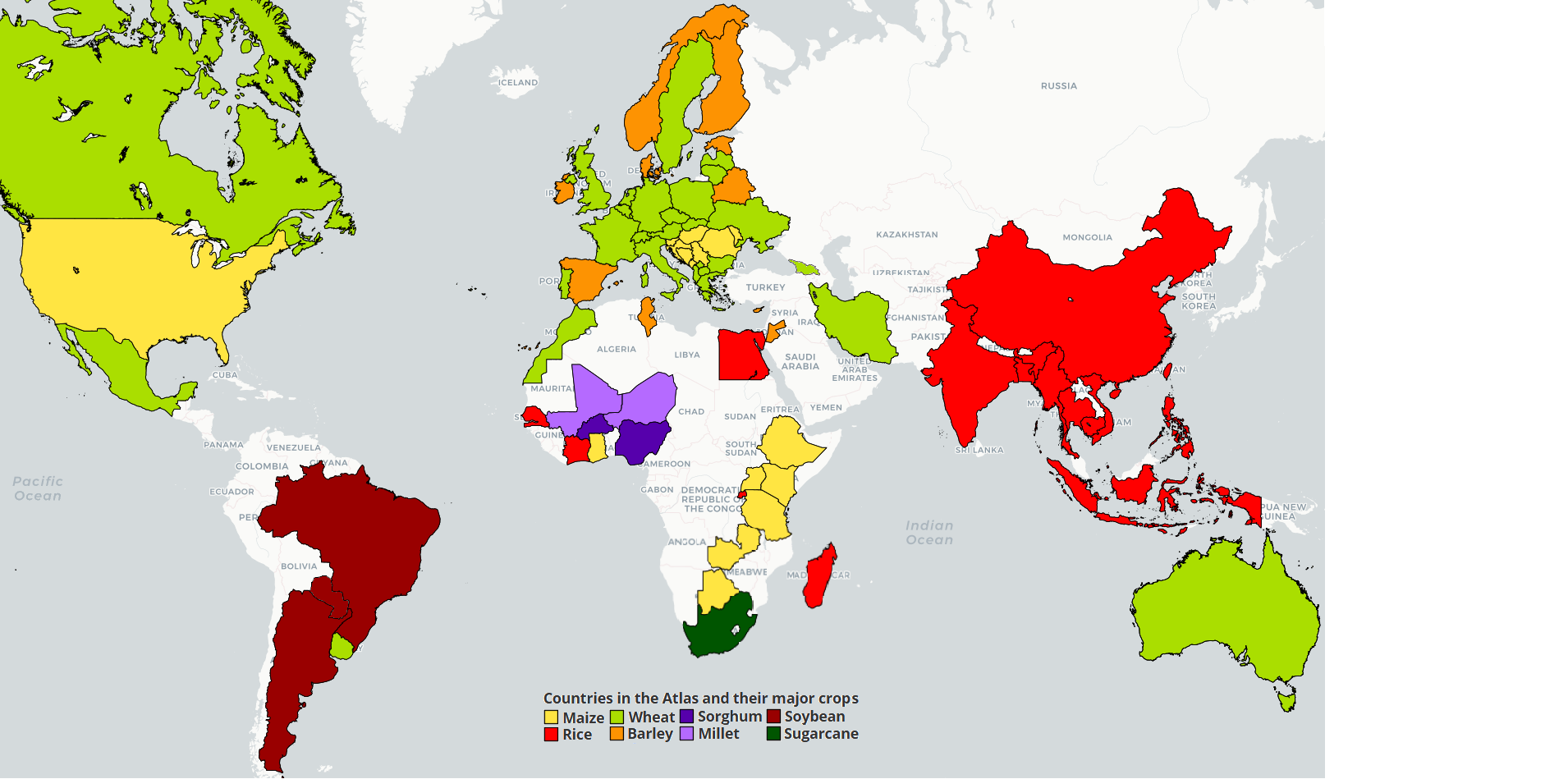Thailand
Rice production in the five Southeast Asian countries, Vietnam, Thailand, Myanmar, Philippines, and Cambodia
The annual average rice production and rice harvested area totaled among these five Southeast Asian countries are 128.5 Mt and 32.0 M ha, respectively (Table 1), accounting for a respective 17% and 20% of global total rice production and harvested area (FAOSTAT, 2020). Climate varies from tropical in the southern lowlands to temperate in the northern highlands. Precipitation pattern can be characterized as monsoonal, with two distinct seasons: wet and dry (Laborte et al., 2010). The dry season occurs roughly from November to March, and the wet season prevails from May to September. Season names (winter, summer) are associated with variation in rainfall rather than temperature. Rice is the major food staple crop in the region. Average annual production, harvested area, and average yield per harvested area per country are shown in Table 1. Also shown is the percentage of rice harvested areas with irrigation. Cropping systems are very diverse in these five Southeast Asian countries, including different ecosystems (upland and lowland), and water regimes (rainfed and irrigated) (Timsina et al., 2011). Here we focused on lowland production, either rainfed or irrigated, as upland rice account for a very small proportion of national harvested area in each of the countries (<5%). Crop intensity (number of crops grown per ha during one year) varies from 1 to 3 crops per year. Rice crop calendars are shown for different regions in each country (Figure 1).
Vietnam is the world’s fifth-largest rice-producing country in rice production in 2018 (FAOSTAT, 2020). Annual rice production has continuously increased from 31 Mt in 1999 to 44 Mt in 2018. Average rice yield is 5.69 t/ha (Table 1). Almost all rice in Vietnam is grown with irrigation (89% of national rice area). Most of rice is produced in the Mekong and the Red River deltas (GRiSP, 2013). In the Mekong Delta, two to three rice crops can be grown per year, while double-season rice is the dominant system in the Red River Delta (Figures 1 and 2).
Thailand is the sixth largest rice-producing country in the world, with a total rice production of 32.2 Mt in 2018 (FAOSTAT, 2020). Major rice growing areas are located in the north, central, and northeast regions, accounting for a respective 20%, 24%, and 50% of the national rice area (GRiSP, 2013; USDA, 2015). Rice is produced across a wide range of environments, including irrigated, lowland rainfed, deepwater, and upland (Kupkanchanakul, 2000). Lowland rainfed and irrigated rice production are the most dominant systems (Varinruk, 2017), accounting for a respective area of 6.2 and 4.1 M ha (USDA, 2015). Average rice yield in Thailand (3.01 t per harvested ha) is lower compared with the other four countries because the prevalence of the relatively large share of lowland rainfed production and farmers’ preference to grow photoperiod-sensitive rice varieties such as aromatic rice and glutinous rice, that typically have lower yield potential (Haefele et al., 2006; Boling et al., 2011).
Myanmar is the world’s seventh-largest rice-producing country in 2018 (FAOSTAT, 2020). Rice is grown during two seasons per year (called monsoon and summer), with 5.6 and 1.2 M ha planted with rice during the monsoon and summer season, respectively. Lowland rainfed and irrigated rice are the most important rice ecosystems, accounting for ca. 65% and 20% of national rice harvested area, respectively (Mutert and Fairhurst, 2002). Lowland rainfed rice is primarily grown in the Ayeyarwady delta region and the strip of land along the coast in the Rakhine State. Irrigated rice is mainly grown concentrated mainly in the central area as well as the Ayeyarwady delta region. Average annual production of rice is 26 Mt and average yield is 3.83 t per harvested ha (Table 1).
The Philippines ranked eighth in world rice production in 2018 (FAOSTAT, 2020). Rice is widely grown in Luzon, Western Visayas, Southern Mindanao, and Central Mindanao. For the past two decades, rice production has increased from 12 Mt in 1999 to 19 Mt in 2008 (FAOSTAT, 2020). The annual-mean of total rice harvested area is ca. 4.7 M ha and average yield is ca. 3.95 t per harvested ha in the Philippines (Table 1). Almost 60% of the total rice harvested area is irrigated; most of the remaining rice is grown in lowland rainfed conditions (Table 1). About 70% of national rice production comes from Luzon (Roberts et al., 2009). Much of the irrigated rice production is concentrated in the central plain of Luzon while rainfed rice is concentrated in the northern Luzon and coastal plains of Visayas (Huke, 1982).
Cambodia is the eleventh largest rice producing country in the world in 2018. Rice area has increased since the 1990s, from 2.1 M ha in 1999 to 3 M ha in 2018 (FAOSTAT, 2020). National average yield has increased from 1.9 to 3.6 t per harvested ha during the period from 1999 to 2018, with national rice production reaching 10.6 Mt in 2018. Rice in Cambodia is grown in lowland rainfed, irrigated, upland rainfed, and deepwater ecosystems (Cosslett and Cosslett, 2018). Lowland rainfed rice is produced across all provinces. The proportion of irrigated rice is still relatively low, although it has increased substantially in recent years, from 15% in 2006 to 25% in 2010 (GRiSP, 2013).
Table 1. National average total rice production, harvested area, and average yield for Vietnam, Thailand, Myanmar, Philippines, and Cambodia between 2014 and 2018. Source: FAOSTAT, 2020 (http://www.fao.org/faostat/en/#data/QC); You et al., 2014.
| Country | Total production (Mt) | Harvested area (Mha) | Average yield (t/ha) | Irrigated rice (as % of total rice area) |
| Vietnam | 44.0 | 7.7 | 5.69 | 89 |
| Thailand | 30.1 | 10.0 | 3.01 | 21 |
| Myanmar | 25.9 | 6.8 | 3.83 | 17 |
| Philippines | 18.6 | 4.7 | 3.95 | 59 |
| Cambodia | 9.9 | 2.9 | 3.41 | 16 |
Figure 1

Figure 1. Dominant rice cropping systems in Vietnam, Thailand, Myanmar, Philippines, and Cambodia. Boxes show approximate crop cycle length (from establishment to harvest maturity). Blue and yellow colors indicate irrigated and rainfed lowland rice, respectively. Gray color represents other crops grown in the sequence. Numbers on the right hand indicate the approximate proportion of rice harvested area accounted for each cropping system in each region.
Selection of buffers and reference weather stations
SPAM (Spatial Production Allocation Model; https://www.mapspam.info/) maps were used to identify the rice harvested area, separately for irrigated and rainfed rice (You et al., 2009, 2014). Regions with a high proportion of upland rice (e.g., highlands in Vietnam) were discarded based on expert opinion from country agronomists. In the case of Thailand, while the reported total rice area by SPAM was fairly accurate, it exhibited important discrepancies in relation to the fraction of rice area that is irrigated. Hence, we modified SPAM maps using data on fraction of irrigated rice land reported by Varinruk (2017) to better portray the spatial distribution of irrigated and lowland rainfed rice.
A total of 38 and 37 buffers were selected for irrigated and lowland rainfed rice in these five countries, respectively (Table 2). Taking into consideration the climate zones where the selected buffers are located, these climate zones (CZs) account for 81%, 65%, 67%, 87%, and 95% of irrigated rice area in Vietnam, Thailand, Myanmar, Philippines, and Cambodia, respectively; 75%, 62%, 74%, and 73% of rainfed rice area in Thailand, Myanmar, Philippines, and Cambodia (Table 2), respectively. We note that the coverage was lower for lowland rainfed rice compared with irrigated rice as the area planted with lowland rainfed rice tended to spread out across larger geographic areas, especially in Thailand and Philippines. Southern Thailand was not included in this analysis (Figure 2), due to the lack of measured weather data in this region and the relatively low rice production compared with other provinces (ca. 2% of national rice production).
Table 2. The number of selected buffers and the percentage of area covered by the selected buffers and climate zones (CZ, %) of irrigated and rainfed rice for Vietnam, Thailand, Myanmar, Philippines, and Cambodia.
| Country | Irrigated | Rainfed | |||||
| Buffer number | Buffer coverage | CZ coverage | Buffer number | Buffer coverage | CZ coverage | ||
| Vietnam | 7 | 69 | 81 | - | - | - | |
| Thailand | 6 | 40 | 65 | 12 | 32 | 75 | |
| Myanmar | 8 | 64 | 67 | 9 | 51 | 62 | |
| Philippines | 12 | 59 | 87 | 10 | 32 | 74 | |
| Cambodia | 5 | 77 | 95 | 6 | 56 | 73 | |

Figure 2. Selected weather stations in Vietnam, Thailand, Myanmar, Philippines, and Cambodia. Black circle is weather station. Background green color is density of rice harvested area, and the darker green, the higher density of rice harvested area (You et al., 2014).
Measured weather data for the most recent 10 years were available for 74 buffers, but no measured daily weather data existed for 3 buffers of Thailand; hence, NASA-POWER were used to generate weather data for these three buffers (NASA-POWER; NASA, 2020). Measured daily weather data including daily solar radiation, maximum and minimum temperature, precipitation, vapor pressure deficit, and wind speed for all weather stations in Vietnam (2009-2018) and Philippines (2008-2017) were obtained from Vietnam Institute of Meteorology, Hydrology and Climate Change (IMHEN) and Philippine Atmospheric, Geophysical and Astronomical Services Administration (PAGASA), respectively. Climatic variables, including maximum and minimum temperature and precipitation, for weather stations in Thailand (2009-2018), Myanmar (2010-2019), and Cambodia (2010-2019) were obtained from Thai Meteorological Department, Department of Meteorology and Hydrology of Myanmar, and Department of Climatology of Cambodia, respectively. Other weather variables (daily solar radiation, wind speed, and relative humidity) were retrieved from NASA-POWER (NASA-POWER; NASA, 2020). Vapor pressure deficit for Thailand, Myanmar, and Cambodia were computed from maximum and minimum temperature and relative humidity (Allen et al., 1998). Weather data for each selected weather station are subjected to quality control measures to fill in missing data and identify and correct erroneous values by using linear interpolation to fill out missing minimum and maximum temperatures and NASA-POWER to fill out missing precipitation data.
Crop management data and modeling
Crop management practices for each reference weather station (RWS) buffer zone were retrieved from local agronomists and extension agents. Requested information included: dominant crop sequences, water regime (rainfed/irrigated) and proportion of each of them to the total harvested area, crop establishment method (transplanted/direct-seeded), average sowing/transplanting dates, and dominant cultivar name and maturity. Reported dates of establishment (either direct seeding or transplanting) in the Atlas correspond to mid-point of the (10-day) establishment window reported by local agronomists and extension agents.
Simulations of rice varieties for each region were performed using ORYZA v3 (Li et al., 2013, 2017). Calibrated white rice varieties OM1490, PSBRc80, PSBRc10, and OM1490 were used for simulating yield potential in Vietnam, Myanmar, Philippines, and Cambodia, respectively. In Thailand, white rice variety OM1490 was used for simulation of irrigated rice in the central Plain while fragrant rice variety KDML105 was used for simulation of lowland rainfed rice in north-eastern region. To the extent that it was possible, we attempted to simulate varieties with broad adaptability that are (or were) widely grown in each of the five countries as determined based on previous reports (Nguyen and Tran, 1999; Bouman, 2008; Asian Development Bank, 2016). For example, OM1490 is a high-yielding rice variety widely cultivated by Vietnamese and Cambodian farmers (Van Tinh, 2020). Similarly, PSBRc10 is a short duration high-yielding rice variety and one of the most commonly planted new varieties in the Philippines (Launio et al., 2008). KDML105 is a widely grown rice variety in lowland rainfed environments in northern and north-eastern Thailand (Win et al., 2012). However, availability of genetic coefficients derived from well-managed experiments for these varieties were not always available for all countries. For example, there were no calibrated parameters for rice varieties in Myanmar. In this case, we simulated the variety that more closely represent the current varieties grown in this country as determined via expert opinion.
Crop parameters of OM1490, PSBRc80, and PSBRc10 were retrieved from previously published studies (Li et al., 2013). Briefly, the calibration and validation of the crop model were conducted with two independent datasets using measured data collected from well-managed from field experiment (Li et al., 2013). ORYZA2000 was used to derive the genetic parameters of these four rice varieties through iterating calibration and validation processes with initial values of crop parameters from a widely cultivated variety, IR72. Experimental data from well-managed crops were not available to calibrate model parameters for fragrant rice varieties. Hence, parameters of KDML105 were derived by using the crop parameters from OM1490 as initial value and subsequent addition of photoperiod sensitivity and lower partitioning to grain so that simulated harvest index was around 0.40. These adjustments in model parameters for fragrant rice were based on previously published studies for fragrant rice in north-eastern Thailand and elsewhere (Samson et al., 2002; Haefele et al., 2006; Naklang et al., 2006; Boling et al., 2011).
For irrigated rice, we assumed no water limitation, while simulation of lowland rainfed rice considered precipitation and soil properties influencing the soil water balance. There is high uncertainty in relation with groundwater depth across sites, seasons, and landscapes, and its influence on lowland rainfed rice yields (Boling et al., 2008). Given the range of possible scenarios and associated uncertainties, we simulated water-limited yield potential for lowland rainfed rice for three scenarios of groundwater depth during the entire crop cycle (shallow [10 cm], medium [75 cm], and deep [150 cm]) in Myanmar and Philippines. These three scenarios basically portray non-water limitation (shallow), moderate-drought (medium) and drought-prone (deep) environments. For these simulations, we assumed a puddled clay loam soil and bund height of 25 cm. We also assumed that each groundwater scenario accounts for an equal (33: 33: 33) share of the lowland rainfed rice area in each buffer. Given the sandy soils and high probability of water deficit of lowland rainfed rice in northern and north-eastern Thailand, two scenarios of groundwater depth during the entire crop cycle (favorable [75 cm] and no groundwater) were simulated, using a puddled sandy loam in both cases (Khunthasuvon et al., 1998; Nakland et al., 2006; Rao et al., 2006). Each groundwater scenario was assumed to account for an equal (50: 50) share of the lowland rainfed rice area in each buffer in Thailand. In the case of lowland rainfed rice in northern Thailand, separate simulations were performed for white rice and aromatic rice (because both rice types are grown widely in this area) and the overall Yw as computed by averaging the result Yw for each rice type, after weighting by harvested area. In the case of Cambodia, considering the predominance of both clay loam and sandy loam soil types in rice growing area (White et al., 1997), we simulated water-limited yield potential for lowland rainfed rice in Cambodia for both soil types. In the case of clay loam soils, we simulated three scenarios of groundwater depth (shallow [10 cm], medium [75 cm], and deep [150 cm]) while two scenarios of groundwater depth (favorable [75 cm] and no groundwater) were simulated for the sandy loam soil. We assumed that each groundwater scenario accounts for an equal (33: 33: 33 for clay loam soil and 50: 50 for sandy loam soil) within each soil type and each soil type accounts for an equal share (50: 50) of rice harvested area in each buffer.
For each buffer-year-crop-water regime combination, each crop cycle (in each sequence) x soil type combination was simulated, and then weighted by their relative proportion to retrieve an average yield potential for each buffer zone. The yield gap was calculated as the difference between the yield potential (or water-limited yield potential for rainfed rice) and average on-farm yield. Data on average farmers’ rice yields and rice harvested area for Vietnam (2007-2016), Thailand (2009-2017), Myanmar (2015-2018), Philippines (2014-2018), and Cambodia (2013-2017) were retrieved from General Statistics Office of Vietnam; Ministry of Agriculture and Cooperatives of Thailand; Central Statistical Organization of Myanmar; Philippine Statistics Authority; and Ministry of Agriculture, Forestry and Fisheries of Cambodia, respectively. Simulated yield, actual yields, and yield gaps are all reported at a standard moisture content of 14%.
References
Allen RG, Pereira LS, Raes D, Smith M. 1998. Crop evapotranspiration. Guidelines for computing crop water requirements. FAO Irrigation and Drainage paper 56. FAO.
Asian Development Bank. 2016. Regional: Development and Dissemination of Climate-Resilient Rice Varieties for Water-Short Areas of South Asia and Southeast Asia. Los Baños (Philippines): International Rice Research Institute.
Boling AA, Bouman BAM, Tuong TP, Konboon Y, Harnpichitvitaya D. 2011. Yield gap analysis and the effect of nitrogen and water on photoperiod-sensitive Jasmine rice in north-east Thailand. NJAS-Wageningen Journal of Life Sciences, 58(1-2), 11-19.
Boling AA, Tuong TP, Suganda H, Konboon Y, Harnpichitvitaya D, Bouman BAM, Franco DT. 2008. The effect of toposequence position on soil properties, hydrology, and yield of rainfed lowland rice in Southeast Asia. Field Crops Research, 106, 22-33.
Bouman BAM. 2008. CPWF Project Number 16: Developing a System of Temperate and Tropical Aerobic Rice in Asia (STAR). CGIAR Challenge Program on Water and Food Project Report series; www.waterandfood.org
Cosslett TL, Cosslett PD. 2018. Sustainable development of rice and water resources in mainland Southeast Asia and Mekong river basin. Springer Singapore.
FAOSTAT. 2020. FAO. http://www.fao.org/faostat/en/#data. Accessed on June 25, 2020.
Haefele SM, Naklang K, Harnpichitvitaya D, Jearakongman S, Skulkhu E, Romyen P, Phasopa S, Tabtim S, Suriya-Arunroj D, Khunthasuvon S, Kraisorakul D. 2006. Factors affecting rice yield and fertilizer response in rainfed lowlands of northeast Thailand. Field Crops Research, 98(1), 39-51.
Huke RE. 1982. Rice Area by Type of Culture South, Southeast, and East Asia. Los Baños (Philippines): International Rice Research Institute.
Khunthasuvon S, Rajastasereekul S, Hanviriyapant P, Romyen P, Fukai S, Basnayake J, Skulkhu E. 1998. Lowland rice improvement in northern and northeast Thailand: 1. Effects of fertiliser application and irrigation. Field Crops Research, 59(2), 99-108.
Kupkanchanakul T. 2000. Bridging the rice yield gap in Thailand. Bridging the rice yield gap in Asia and the Pacific. RAP Publication, Bangkok, 2000: 146-156.
Laborte AG, Bie KD, Smaling EMA, Moya PF, Boling AA, Ittersum MKV. 2010. Rice yields and yield gaps in southeast Asia: past trends and future outlook. European Journal of Agronomy, 36(1), 9-20.
Launio CC, Redondo GO, Beltran JC, Morooka Y. 2008. Adoption and spatial diversity of later generation modern rice varieties in the Philippines. Agronomy Journal, 100(5): 1380-1389.
Li T, Angeles O, Marcaida M, Manalo E, Manalili M P, Radanielson A, Mohanty S. 2017. From ORYZA2000 to ORYZA (v3): An improved simulation model for rice in drought and nitrogen-deficient environments. Agricultural and Forest Meteorology, 237, 246-256.
Li T, Raman AK, Marcaida M, Kumar A, Angeles O, Radanielson AM. 2013. Simulation of genotype performances across a larger number of environments for rice breeding using ORYZA2000. Field Crops Research, 149, 312-321.
GRiSP (Global Rice Science Partnership). 2013. Rice almanac, 4th edition. Los Baños (Philippines): International Rice Research Institute. 283 p.
Mutert E, Fairhurst TH. 2002. Developments in rice production in Southeast Asia. Better Crops International vol 15. Suppl: 12-17.
Naklang K, Harnpichitvitaya D, Amarante ST, Wade LJ, Haefele SM. 2006. Internal efficiency, nutrient uptake, and the relation to field water resources in rainfed lowland rice of northeast Thailand. Plant and Soil, 286(1-2), 193-208.
NASA. 2020. NASA-Agroclimatology methodology. Available at: https://power.larc.nasa.gov/data-access-viewer/. Accessed on June 25, 2020.
Nguyen VN, Tran DV. 1999. FAO rice information. FAO.
Orachos Napasintuwong. 2019. Rice Economy of Thailand. ARE Working Paper No. 2562/1 (January 2019). Department of Agricultural and Resource Economics, Faculty of Economics, Kasetsart University, Bangkok, Thailand.
PAGASA (Philippine Atmospheric, Geophysical and Astronomical Services Administration). 2020. Climate of the Philippines. http://bagong.pagasa.dost.gov.ph/information/climate-philippines.
Rao RN, Finck A, Blair GJ, Tondan HL. 2006. Plant nutrition for food security. A guide for integrated nutrient management. Fertilizer and Plant Nutrition Bulletin. 2006;16.
Roberts MG, Dawe D, Falcon WP, Naylor RL. 2009. El Niño-Southern Oscillation impacts on rice production in Luzon, the Philippines. Journal of Applied Meteorology and Climatology, 48(8), 1718-1724.
Samson BK, Hasan M, Wade LJ. 2002. Penetration of hardpans by rice lines in the rainfed lowlands. Field Crops Research. 76(2-3), 175-188.
Senga, K. 2004. Greater Mekong Subregion Atlas of the Environment. Metro Manila (Philippines): Asian Development Bank.
Timsina J, Buresh RJ, Dobermann A, Dixon J. 2011. Rice-maize systems in Asia: current situati on and potential. Los Baños (Philippines): International Rice Research Institute and International Maize and Wheat Improvement Center. 232 p.
USDA. 2015. Thailand: Irrigation Shortage Reduces 2015/16 Rice Production. https://apps.fas.usda.gov/psdonline/app/index.html#/app/home. Accessed on June 25, 2020
Van Tinh T. The Cross-Border Trade in Rice from Cambodia to Vietnam. InWhite Gold: The Commercialisation of Rice Farming in the Lower Mekong Basin 2020 (pp. 397-412). Palgrave Macmillan, Singapore.
Varinruk B. 2017. Thailand Rice Production and Rice Research and Development on Climate Change. In: Workshop on Strengthening APEC Cooperation on Food Security and Climate Change, Ha Noi, Vietnam, 19-21 April 2017. http://103.95.217.9/mddb.apec.org/Documents/2017/PPFS/WKSP1/17_ppfs_wksp1_008.pdf. Accessed on July 8, 2020.
White PF, Oberthür T, Sovuthy, P. 1997. The soils used for rice production in Cambodia: a manual for their identification and management. Los Baños (Philippines): International Rice Research Institute.
Win KM, Korinsak S, Jantaboon J, Siangliw M, Lanceras-Siangliw J, Sirithunya P, Vanavichit A, Pantuwan G, Jongdee B, Sidhiwong N, Toojinda T. 2012. Breeding the Thai jasmine rice variety KDML105 for non-age-related broad-spectrum resistance to bacterial blight disease based on combined marker-assisted and phenotypic selection. Field Crops Research, 137, 186-194.
World Bank. 2020. World Bank Open Data. https://data.worldbank.org/. Accessed on June 25, 2020.
You L, Wood S, Wood-Sichra U, Wu W. 2014. Generating global crop distribution maps: From census to grid. Agricultural Systems, 127, 53-60.
You L, Wood S, Wood-Sichra U. 2009. Generating plausible crop distribution maps for Sub-Saharan Africa using a spatially disaggregated data fusion and optimization approach. Agricultural Systems, 99, 126-140.
Get access to the Atlas for advanced users
Download GYGA results
 | Please read the license information in case you are interested in using the data from the Global Yield Gap Atlas. |
| read more>> |
 Partners and country agronomists
Partners and country agronomists

Alexander M.Stuart
International Rice Research Institute
Anny Ruth Pame
International Rice Research Institute
Alice G. Laborte
International Rice Research Institute
Kritkamol Paothong
Ayutthaya Rice Research Center, Rice Research and Development Division, Thai Rice Department
Prachya Traesang
Thailand Rice Science Institute, Suphanburi Province, Thailand

